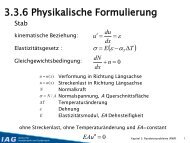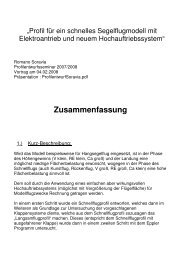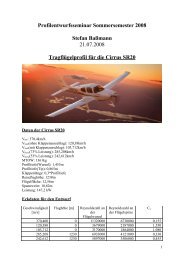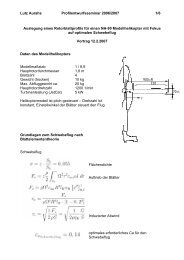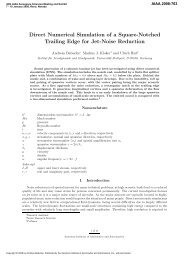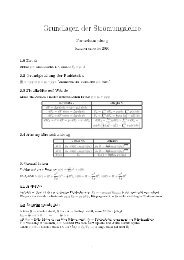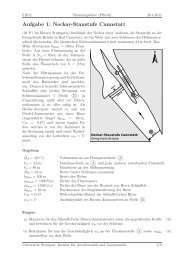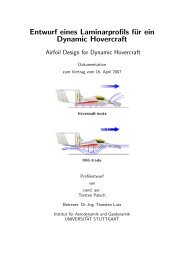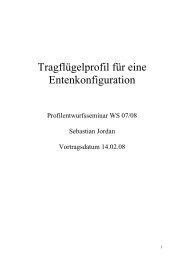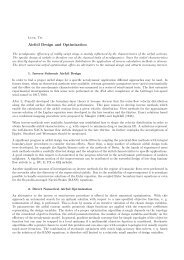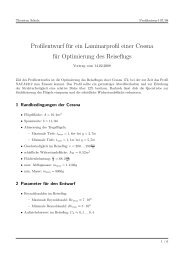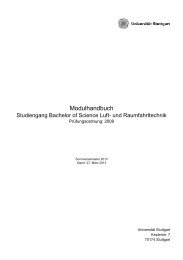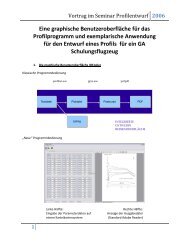part 1: effusion cooling - IAG - Universität Stuttgart
part 1: effusion cooling - IAG - Universität Stuttgart
part 1: effusion cooling - IAG - Universität Stuttgart
Create successful ePaper yourself
Turn your PDF publications into a flip-book with our unique Google optimized e-Paper software.
NUMERICAL INVESTIGATION OF HYPERSONIC WALL-<br />
BOUNDED SHEAR FLOWS – PART 1: EFFUSION COOLING<br />
Jens Linn & Markus J. Kloker<br />
Institut für Aerodynamik und Gasdynamik, Universität <strong>Stuttgart</strong><br />
Pfaffenwaldring 21, 70550 <strong>Stuttgart</strong>, Germany<br />
linn@iag.uni-stuttgart.de<br />
Abstract<br />
Direct numerical simulations (DNS) are carried out<br />
to study the laminar stability properties of an <strong>effusion</strong>cooled<br />
adiabatic flat-plate boundary layer at Mach 6.<br />
Through four aligned rows of holes, cold gas is blown<br />
into the boundary layer at the wall and background disturbances<br />
are excited at the wall upstream of the holes.<br />
Two cases are compared, with small and large spanwise<br />
spacing of the holes. Despite strong localized vortex-like<br />
flow deformations in both cases no strong “secondary”<br />
instability sets in. From studies of incompressible cases<br />
it is known that wall blowing can strongly destabilize the<br />
boundary layer. Thus an “incompressible” reference case<br />
(Mach 0.6) is simulated and compared with the <strong>effusion</strong>cooled<br />
Mach-6 case. Differences are found indicating<br />
that the high Mach number has a stabilizing effect on the<br />
young <strong>effusion</strong>-cooled boundary layer.<br />
1 Introduction<br />
For aerospace or hypersonic cruise vehicle the state<br />
of the boundary layer is of great importance because for<br />
turbulent boundary layers the thermal loads and skin<br />
friction are higher than in laminar boundary layers.<br />
Therefore, knowledge of <strong>cooling</strong> features and laminarturbulent<br />
transition is necessary for the design and the<br />
thermal protection system (TPS). Different strategies are<br />
used to reduce the thermal loads of hypervelocity vehicles,<br />
e.g. radiation, ablation, transpiration or <strong>effusion</strong><br />
<strong>cooling</strong>.<br />
The subject of this paper is the <strong>effusion</strong> or film <strong>cooling</strong><br />
at wind tunnel conditions, where cold air is blown<br />
into an adiabatic Mach-6 boundary layer through spanwise<br />
rows of holes. This implies a change in the laminar<br />
stability properties of the boundary.<br />
2 Numerical Method<br />
The numerical method is based on the complete 3-d<br />
unsteady compressible Navier-Stokes equations in a conservative<br />
formulation. The equations are solved in a rectangular<br />
integration domain on a flat plate, which does<br />
not contain the shock wave induced by the leading edge.<br />
In streamwise (x-) and wall-normal (y-) direction the<br />
discretization is realized by compact finite differences of<br />
6 th order [6]. In the spanwise (z-) direction, the flow is<br />
assumed to be periodic, thus a Fourier spectral representation<br />
is employed. The time integration is done with a<br />
classical 4 th -order Runge-Kutta method. A detailed description<br />
of the algorithm and boundary conditions is reported<br />
in [1,3].<br />
Effusion <strong>cooling</strong> is modelled by prescribing a wallnormal<br />
mass flux (ρv) c and wall temperature T c distribution<br />
over the hole (figure 1) with a polynomial of 5 th order<br />
[7]. In the adiabatic case only T c,core at the hole center<br />
is fixed.<br />
Figure 1: (ρv) c -distribution at the wall for on row of<br />
holes.<br />
3 Results<br />
Here we investigate an adiabatic Mach-6 boundary<br />
layer in which cold air is blown through four aligned<br />
rows of holes. The freestream temperature is T ∞ * = 89K<br />
(≈ 1 / 7·T * rec) and the pressure is p ∞ * = 0.0038bar, matching<br />
the flow parameters of experiments in the hypersonic<br />
wind tunnel H2K of DLR-Köln [2]. Thus, with Re L =<br />
10 5 , the reference values for nondimensionalisation are<br />
L * = 36.28 mm, u * ∞ = 1134.8 m/s, and Re unit = 2.8·10 5 .<br />
Non dimensional values are without asteriks, see also table<br />
1. We look at two cases with different spanwise<br />
spacing s z of the holes. The hole region reaches from Re x<br />
= 2.2·10 5 to 2.75·10 5 . In case A the holes have a small<br />
spanwise spacing s z,A = 3·d c (hole diameter - d c = 0.055 ≈<br />
0.56·δ c ), in contrast to case B where the spanwise spacing<br />
is enlarged (s z,B = 12·d c ). The <strong>cooling</strong> gas temperature<br />
is T * c,core=½·T * rec, the blowing ratio<br />
(ρv) * c/(ρv) * ∞=0.15, and the hole diameter d c is in both<br />
cases equal. Thus the integral massflow through the<br />
holes per spanwise unit is in case B only one quarter of<br />
case A. Investigations based on the primary Linear Stability<br />
Theory (LST) have shown (see, e.g. [8]) that wall<br />
<strong>cooling</strong> stabilises 1 st -mode (vorticity) disturbances and<br />
destabilises 2 nd -mode (acoustic) disturbances.<br />
A crosscut of the u-velocity and temperature field<br />
downstream of the rows is shown in figures 2a) and 2b).
In case B (right), the boundary layer is deformed much<br />
stronger than in case A (left; mushroom like structures).<br />
From the holes, counter-rotating longitudinal vortex<br />
pairs (CVPs) emerge which are along the jet trajectory<br />
and have such a rotation sense that fluid is transported<br />
away from the wall in the streamwise hole center line.<br />
However, the CVPs of both cases decay downstream.<br />
a)<br />
b)<br />
Figure 3: Downstream disturbance-amplitude development<br />
for both cases (A – small spanwise spacing, B –<br />
large spanwise spacing; ω=10 is f * =ωu * ∞/(2πL * )=49.78<br />
kHz).<br />
Figure 2: u-velocity iso-contours in a crosscut (half the<br />
respective spanwise domain width is shown) at Re x =<br />
3.12·10 5 downstream of the holes for case A (left) and<br />
case B (right); 0.05 ≤ u ≤ 1, Δu = 0.05. a) with u-shading<br />
and b) temperature shading.<br />
Upstream of the holes, unsteady 2-d disturbance<br />
waves are generated at Re x = 1.78·10 5 for a bunch of frequencies<br />
to check for laminar instability. Note that, due<br />
to the large steady vortices, 3-d unsteady disturbances<br />
are nonlinearly generated with the 2-d packet.<br />
Figure 3 shows the downstream development of the<br />
u-disturbance amplitudes (u´h – maximum over y and z)<br />
from a timewise Fourier analysis for both cases. The<br />
curve (0,0) represents the timewise and spanwise mean<br />
flow deformation of the 2-d boundary layer. In case A<br />
(0,0) is stronger than in case B due to the higher injected<br />
massflow per spanwise unit and the 3-d deformation is<br />
less, resulting in an approximately equal level of the<br />
curve ω = 0 that includes both effects. All frequencies<br />
are damped or are neutral for Re x > 5·10 5 , except frequencies<br />
near ω = 10, being also amplified in the pure 2-<br />
d base flow as a 2 nd mode. Here, however, it is a<br />
Figure 4: Amplitude distribution (shaded) and mean<br />
flow (isolines) at Re x = 6.5·10 5 for case B; 0.1 ≤ u ≤ 1,<br />
Δu = 0.1.<br />
disturbance localized in the y-z plane as a localized secondary<br />
mode (figure 4). In case B this frequency is amplified<br />
much stronger, despite a reduced receptivity. Low<br />
frequencies are neutral or damped like in case A (we<br />
checked down to ω=1). Thus the steady 3-d flow deformation<br />
by blowing does not invoke sudden transition in<br />
the young boundary layer in the front <strong>part</strong> of the plate. A<br />
small spanwise hole spacing is preferable due to larger
<strong>cooling</strong> effectiveness and lower amplification of unsteady<br />
disturbances.<br />
Low M-case C Case B<br />
M ∞ 0.6 6.0<br />
T * ∞ 290 K 89 K<br />
u * ∞ 204.8 m/s 1135.8 m/s<br />
p * ∞ 1.0 bar 0.0038 bar<br />
L * 7.25 mm 36.28 mm<br />
Re unit 13.8·10 6 1/m 2.8·10 6 1/m<br />
Re L 10 5 10 5<br />
Wall condition adiabatic adiabatic<br />
T * rec 307.6 K 629 K<br />
T c,core 290 K 293 K<br />
v * c/u * ∞ 0.15 0.45<br />
d c /λ z 0.105 0.105<br />
Table 1: Parameters of the Mach-0.6 (C) and Mach-6<br />
case (B).<br />
From investigations of incompressible boundary<br />
layers it is known that blowing often strongly<br />
destabilizes the boundary layer. Thus a Mach-0.6 case<br />
(C) is simulated and compared with case B to clarify the<br />
effects. We chose an equal R x =469.57 = Re x ½ at the first<br />
row of holes in both cases. Table 1 summarizes the<br />
simulation parameters. The Mach-0.6 case C has a five<br />
times larger unit Reynolds number Re unit due to the<br />
smaller (≈ 1 / 27 ) kinematic viscosity. Furthermore we<br />
chose equal length scales ratios in both cases (s x /δ c =<br />
const.; s z /δ c = const.; d/δ c = const.) and equal blowing<br />
ratios (ρv) * c/(ρv) * ∞=0.15.<br />
blowing velocity. It is in the Mach-6 case B three times<br />
larger than in the Mach-0.6 case C, due to the different<br />
<strong>effusion</strong> densities (ρ Mach-0.6 ≈1; ρ Mach-6 ≈ 1 / 3 ).<br />
Figure 6: Visualisation of the u-velocity field in a crosscut<br />
at three boundary-layer thicknesses downstream the<br />
last row of holes.<br />
In figure 7 the gradients ∂u/∂y and ∂u/∂z are shown<br />
in the same crosscut as in the previous figure. The gradients<br />
in the low Mach number case (C) are much larger<br />
than in case B due to the blowing. Furthermore the<br />
maximum of the gradients lay closer to the wall in case<br />
C. We note that, for a free shear layer, the dimensional<br />
disturbance growth rate is proportional to ∂u/∂y·(u * ∞/L * ),<br />
the expression in brackets being almost equal for the two<br />
cases.<br />
Figure 5: Comparison of u-velocity baseflow profiles at<br />
R x =469.57 (= Re x ½ ) without blowing for the two different<br />
Mach numbers.<br />
In figure 5 the u-velocity profiles of the baseflow at<br />
the position of the first row of hole is shown. The wall<br />
gradient ∂u/∂y| w·δ c in the Mach-0.6 case is larger than in<br />
the Mach-6 case. With increasing Mach number, the skin<br />
friction and thus ∂u/∂y at the wall decreases.<br />
A crosscut of the u-velocity field is shown in figure 6<br />
at three boundary-layer thicknesses downstream of the<br />
last row of holes. In case C, we did not obtain a steady<br />
solution, due to self-excited unsteadiness of the boundary<br />
layer at the fourth hole row. Therefore in figure 6 the<br />
time mean of the u-velocity field is shown. The deformation<br />
of the boundary layer in case C is stronger than in<br />
the other case and closer to the wall due to the different<br />
Figure 7: Contour plot of ∂u/∂y (upper figure) and ∂u/∂z<br />
(lower figure) in a crosscut behind the holes for cases C<br />
(left) and B (right).<br />
The vortical structures (λ 2 -criterion, [5]) are shown in<br />
figure 8. In the Mach-0.6 case (snapshot) downstream<br />
travelling Λ vortices are directly generated by blowing at
the fourth hole row. This is in contrast to the Mach-6<br />
case, where only a pair of steady longitudinal vortices is<br />
generated at each hole that decays downstream.<br />
Figure 8: Visualisation of the vortical structures via λ 2 -<br />
isosurfaces for the Mach-0.6 (case C, snapshot) and<br />
Mach-6 case (case B). 42 or 85 spanwise harmonics have<br />
been computed.<br />
4 Conclusion<br />
In this paper we investigate the laminar instability of<br />
an adiabatic <strong>effusion</strong>-cooled Mach-6 boundary layer<br />
with four aligned row of holes and different spanwise<br />
hole spacings. We observe no transition at Mach 6, i.e.<br />
no explosive “secondary” instability of the mushroomlike<br />
structures generated by the vortices. The results<br />
show a destabilisation effect only with large spanwise<br />
spacing. In a low Mach-number reference case (Mach<br />
0.6) self-excited unsteadiness by strong growth of background<br />
disturbances occurs. In this case Λ-vortices are<br />
generated at the last hole row, travelling downstream.<br />
The low Mach-number case has a stronger wall shear<br />
∂u/∂y| w and also stronger shear maxima ∂u/∂y| max in the<br />
longitudinal-cut plane and ∂u/∂z| max in the wall-parallel<br />
plane due to the deformation by blowing than the Mach-<br />
6 case. For <strong>effusion</strong> <strong>cooling</strong> a small spanwise spacing is<br />
preferable, not only because of the lower destablisation<br />
effect but also of the larger <strong>cooling</strong> effectiveness.<br />
References<br />
[1] A. Babucke, J. Linn, M. Kloker, U. Rist, Direct<br />
numerical simulation of shear flow phenomena on<br />
parallel vector computers, In High Preformance<br />
Computing on Vector Systems (ed. M. Resch & el.),<br />
Proc. High Performance Computing Center <strong>Stuttgart</strong>,<br />
Springer, pp. 229-247, 2003.<br />
[2] M. Bierbach, Untersuchnungen zur aktiven Kühlung<br />
der Grenzschicht an einem Plattenmodell,<br />
Diplomarbeit, Technische Universität Darmstadt,<br />
2005.<br />
[3] W. Eißler, H. Bestek, Spatial numerical Simulations<br />
of linear and weakly nonlinear wave instabilities<br />
in supersonic boundary layers, Theoret. Comput.<br />
Fluid Dynamics, vol. 8, pp. 219-235, 1995.<br />
[5] J. Jeong, F. Hussain, On the indentification of a<br />
vortex, J. Fluid Mech., vol.285, pp.69-94, 1995.<br />
[6] M. Kloker, A robust high-resolution split-type<br />
compact FD-scheme for spatial direct numerical<br />
simulation of boundary-layer transition, Applied<br />
Scientific Research, vol. 59, pp. 353-377, 1998.<br />
[7] J. Linn, M.J. Kloker, Numerical investigations of<br />
<strong>effusion</strong> <strong>cooling</strong> in hypersonic boundary-layer<br />
flow, In New Results in Numerical and Experimental<br />
Dynamics VI (ed. S. Jakirlic, C. Tropea, H.-J.<br />
Heinemann, R. Hilbig), NNFM, vol. 96, Springer,<br />
2007.<br />
[8] M.R. Malik, Prediction and control of transition in<br />
supersonic and hypersonic boundary layers, AIAA-<br />
Journal, vol. 27, pp 1487-1493, 1989.<br />
Acknowledgements<br />
The <strong>part</strong>ial financial support of this work by the<br />
Helmholtz-Gemeinschaft (HGF) within project A8 of the<br />
RESPACE (Key Technologies for Reusable Space Systems)<br />
group is gratefully acknowledged. We thank the<br />
Höchstleistungsrechenzentrum <strong>Stuttgart</strong> (HLRS) for<br />
provision of supercomputing time and technical support<br />
within the project “LAMTUR”.




